Continuing the posting of recent-ish photos (meaning those mostly taken while I was hashing out my ignorance of PHP to make things look ‘acceptable,’) we have these various offerings from the environs immediately surrounding Walkabout Studios, what the proletariat tend to refer to as the “front and back yards;” we will attempt to elevate this missive by using, at a minimum, the terms, “anterior and posterior meters.”
We’ll start off with a reappearance.
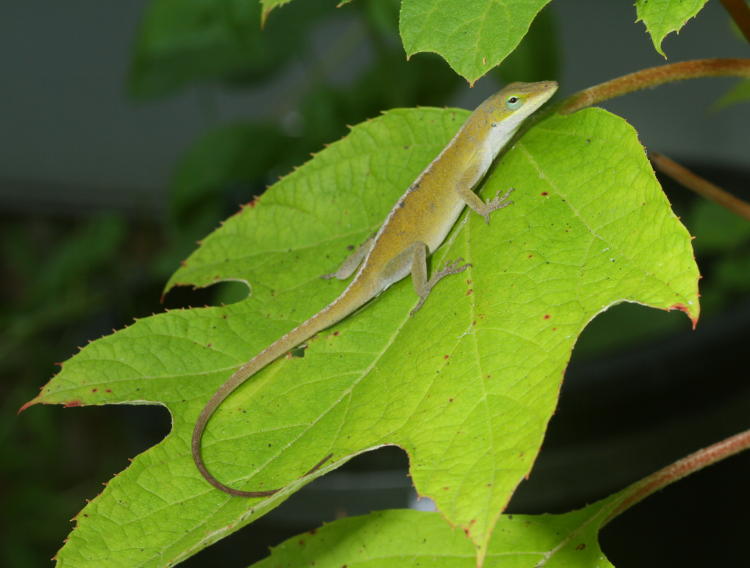
A little over a month ago, I was pleased to spot the first ever Carolina anole (Anolis carolinensis) in the anterior meter, but then hadn’t seen it at all afterward – until a few days ago. It provided several poses on the oak-leaf hydrangea (Hydrangea quercifolia) while eyeing me suspiciously. I’d like to encourage it to remain, but I’m not sure what I could do to make it more welcome, save for not bothering it too much. They like ants, but there are already beaucoup ants in that region so that bit’s covered. I have vague suspicions, from the coloration, that this one is female, so any male anoles that are looking for a neat place to stay should get in contact.
I had also remarked, many years back, that I was hoping to get the green treefrogs (Hyla cinerea) more established in the yard, and I was certainly successful in that aspect, though the only part I played, if any, was providing a pond for breeding. The greens now outnumber the Cope’s greys by a significant margin and are easy to find just about any evening, and fairly often in the daytime, hiding out someplace waiting for the night’s food sources. Since they are prolific over at the neighborhood pond too, I doubt I had a hand in this at all, but hey, I’m good with the result. I’ll have to stake them out some evening and try to get video of them capturing food, but for the past few weeks, even the late-night temperatures are pretty uncomfortable, so I’ll need some motivation. Right now we gots still pichers, like this pose that I’m rather fond of.
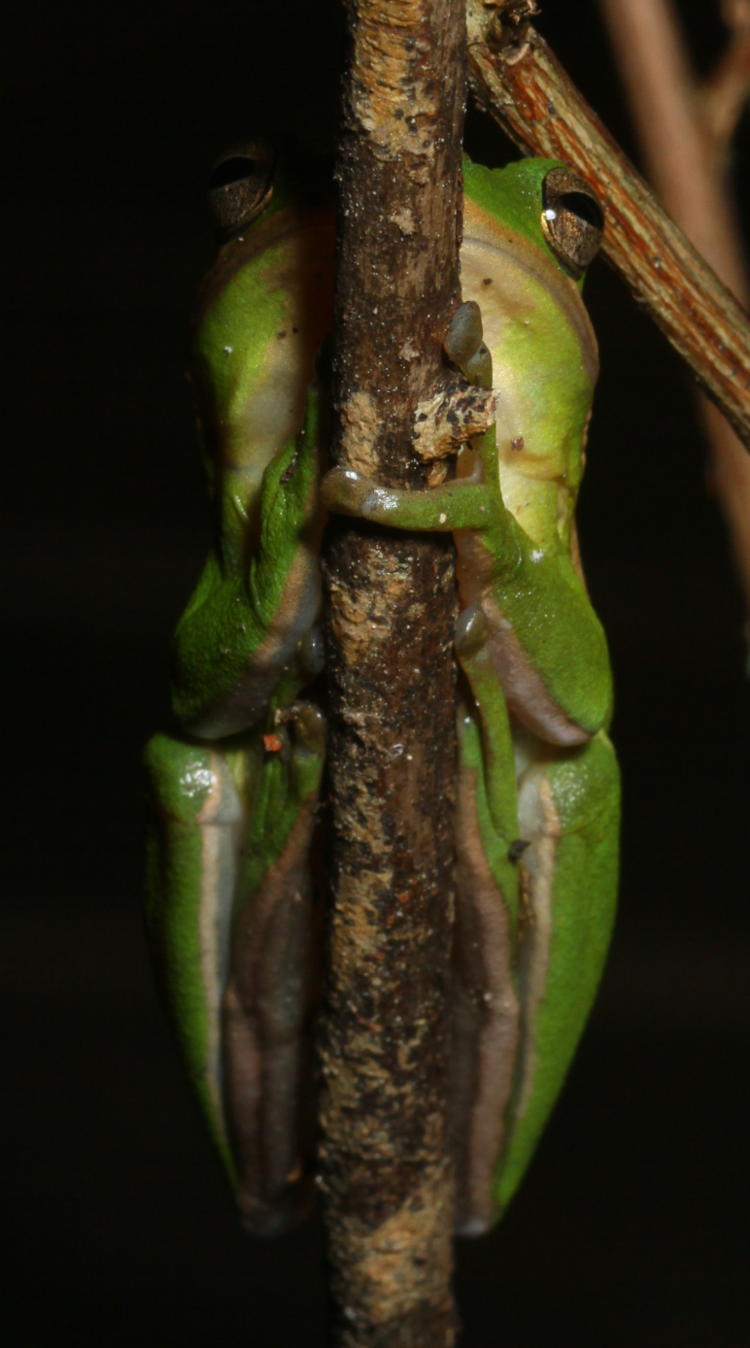
This was on a potted plant on the back deck, which they seem to like. I have to routinely check the grill over before each use, to be sure that neither the greens nor the greys have decided to hole up for the day under the cover. It occasionally leads to some interesting finds.
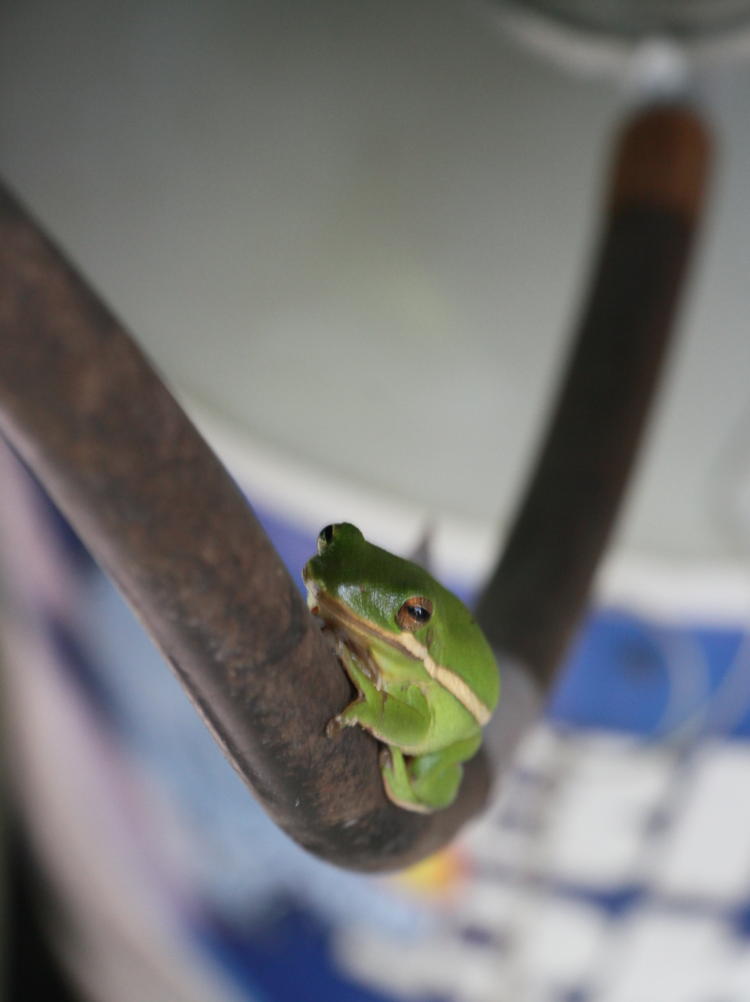
This is the supply hose from the propane tank. and while it was technically far enough to avoid most of the heat from the operation of the grill, I couldn’t be sure this guy wouldn’t get alarmed and jump someplace a lot more dangerous, so I moved it to a plant nearby before cooking dinner. Is it the same one in both photos? Could be – one of these days I’ll find a way to tell them apart. I’m reasonably certain this could be done accurately with a close examination of their iris patterns, but that’s not an easy method to implement.
Supposedly, we should have a lot more greys showing up too.
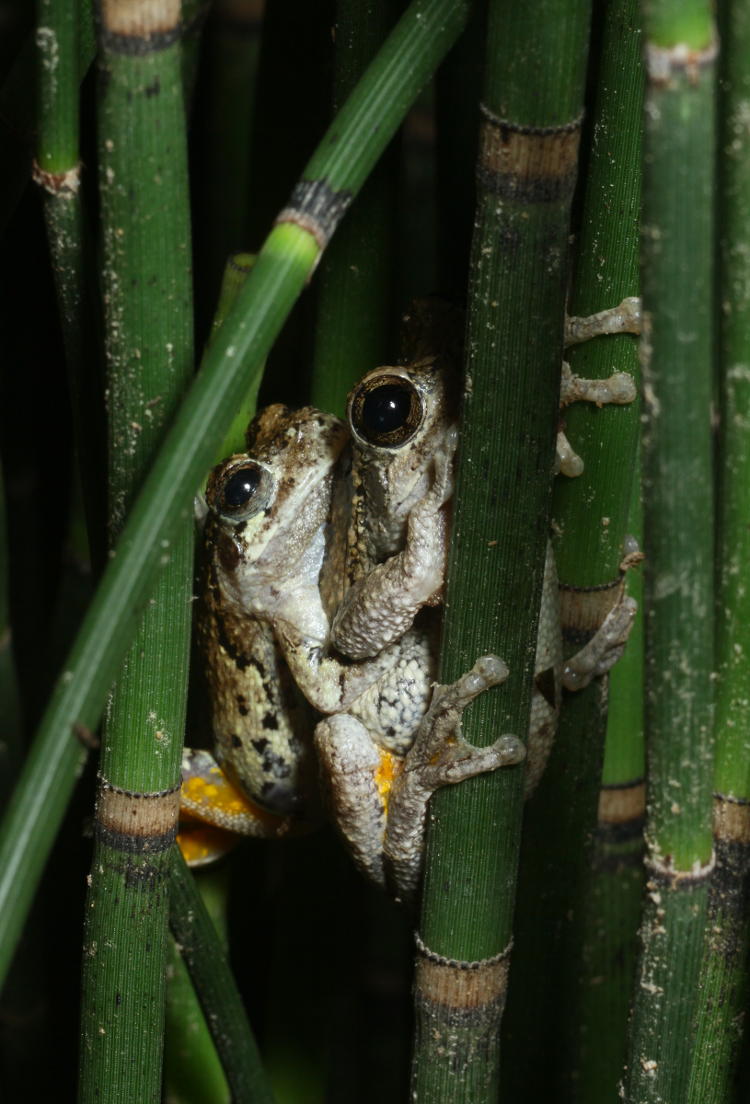
Back when we were actually getting rain, I would find a male calling from the posterior meter pond, and one night it became clear that this was successful. However, something odd has happened to the water therein, and none of the green frogs, nor the snails, nor any aquatic insect, seems to be living in there anymore, though the plants (like the scouring rush seen here) are doing fine. I can’t imagine why it suddenly became uninviting, but might have to drain it later this summer. I saw no evidence of eggs or tadpoles, though, so perhaps this happy couple found a better place to spawn.
A few weeks back, the meter suddenly erupted with tiny American toads (Anaxyrus americanus,) about thumbnail size and extremely well camouflaged, until they attracted attention by hopping out of the way. They didn’t like me leaning in with the macro rig, but I managed to follow one until it paused long enough.
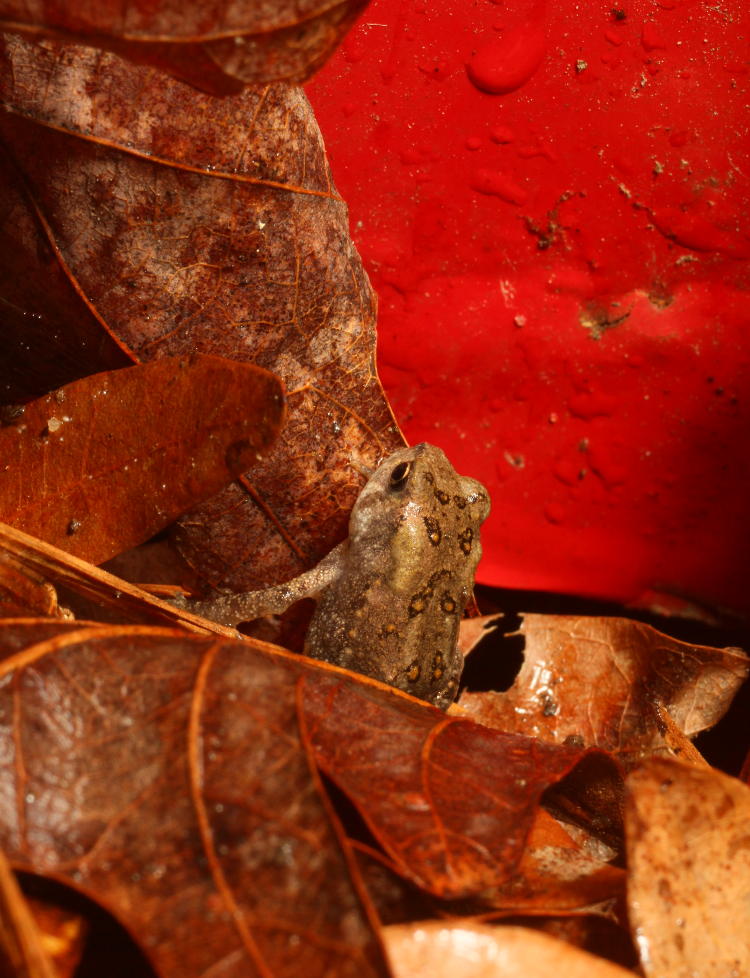
That bright red background is the same one seen here, though I have not seen a repeat of that performance since. C’mon, you know I couldn’t avoid posting it here if I did.
Only moments later and meters away (I mean, same posterior meter, but this time I’m referring to the 100cm kind,) I found a massive adult, so you can compare them.
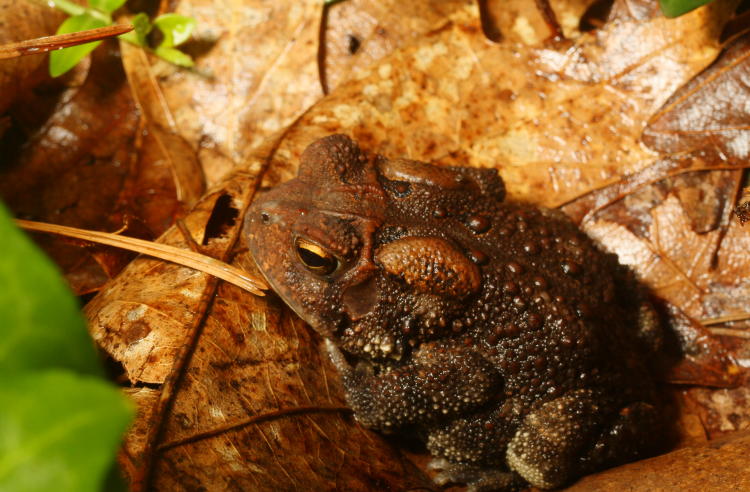
Toads reproduce like frogs, laying their eggs in water to hatch into tadpoles before growing legs and emerging from the water, so the sudden abundance of toads right here would seem to indicate that the pond had been put to good use – except that I never saw any sign of tadpoles, much less the dozens that would have been necessary to spark the numbers seen in the meter. There are, to my knowledge, no other water sources nearby, save for the drainage channel off the back of the property, just far enough that I wouldn’t have thought so many toads would end up here, but I could be wrong about that.
We’ll be moving on to the arthropods now. Please return to your seats.
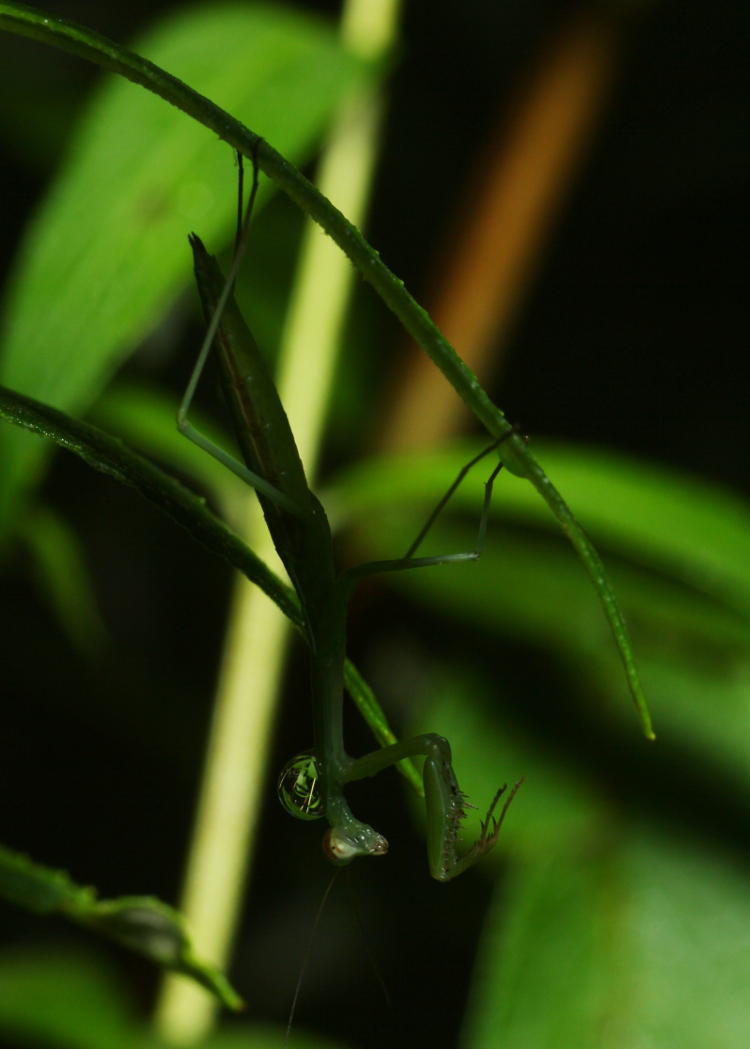
Back when we were actually getting decent rains, I went out not too long after a storm and found this juvenile Chinese mantis (Tenodera sinensis) sporting the latest in spring fashion – ha! That’s a brilliant joke, because this was taken on June 20, the first day of summer! While the flash unit didn’t cut through the leaves onto the mantis terribly well, I was pleased with how the drop showed the background, though it would have been nicer had it captured a blossom cluster of this butterfly bush for a splash of color. Ah well.
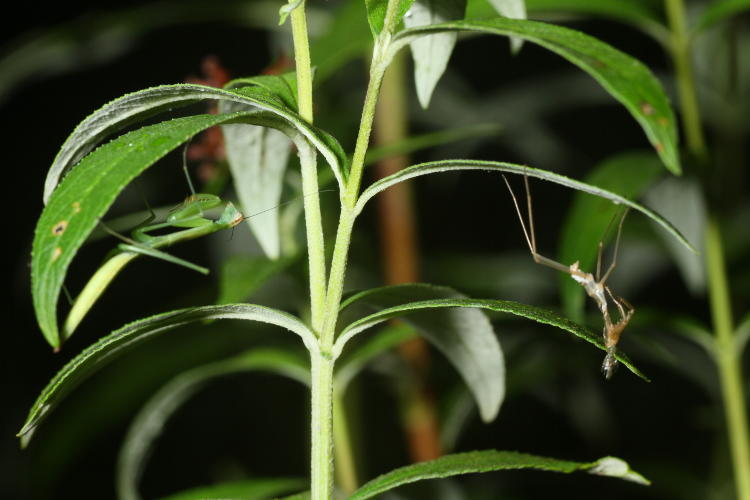
Later on that day, I found that the same one had just molted while underneath the leaves; I hadn’t noticed any signs of impending molt earlier, but they’re fairly subtle as it is.
At present, there are a wide range of sizes among the mantids, courtesy of both different hatching times and different species, with a nod towards more and less successful specimens I suppose. That same butterfly bush is now home to a pair of juvenile Carolina mantids (Stagmomantis carolina) – much smaller, and able to almost entirely disappear among the old and new blossoms.

This species hatches over a month later than the Chinese mantises and as adults are only about half the size, so here, it’s not a lot larger than a newborn Chinese, probably 12-14mm in body length. As such, they’re not tackling a lot, but that’s okay; the butterfly bushes attract a very broad range of pollinators and nectar-seekers, part of the reason why I like having them in the meter. And here’s another:

I took this frame both the show scale and to illustrate how tricky it is to spot my next subject; if you’re familiar with butterfly bushes, you’ll know that the blossom clusters tend to be a little broader than your thumb, but about the same length, and if you’re not, well, they’re a little broader than your thumb but about the same length. And in there sits an occupant that I always encourage: a white-banded crab spider (Misumenoides formosipes) – look hard, you’ll find it. But sure, I went in for a better look.
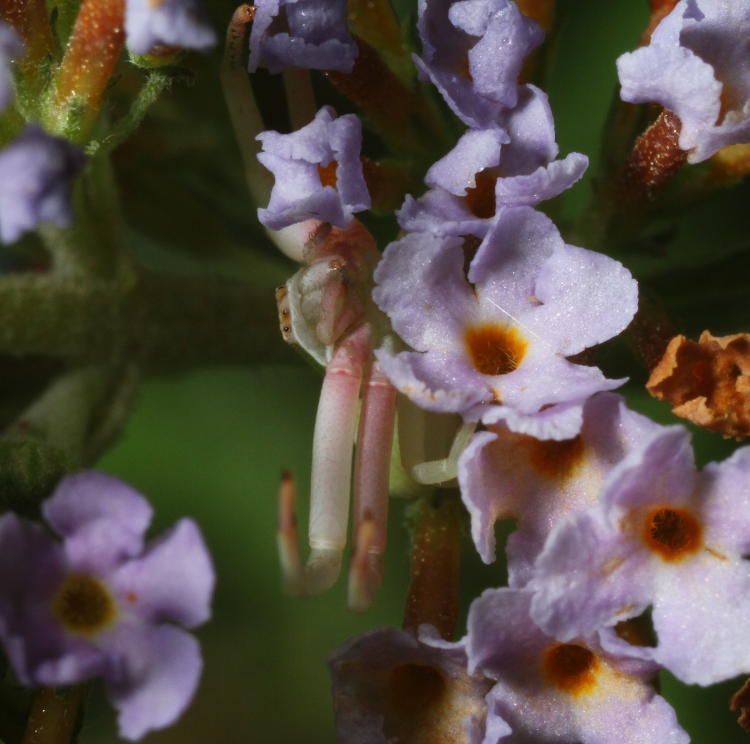
Even this close, it may not be very clear, given that there is only a partial view and at an atypical angle, but you’re looking straight into the face of the spider here, a row of eyes atop the hump of the head (cephalothorax) on the left, the legs spread wide in capture position. Any insect of the right size hits that one blossom and they’re toast, and crab spiders can tackle prey a lot larger than themselves. This one is still pretty small, but it has the opportunity to get a lot bigger. Provided it escapes the attention of the mantids, of course, yet chances are it will. Mantises hunt by movement, which crab spiders avoid, while if danger threatens the spider can dig deeper into the spaces between the blooms. They can easily share the plant.
Some of the mantises are getting big now.
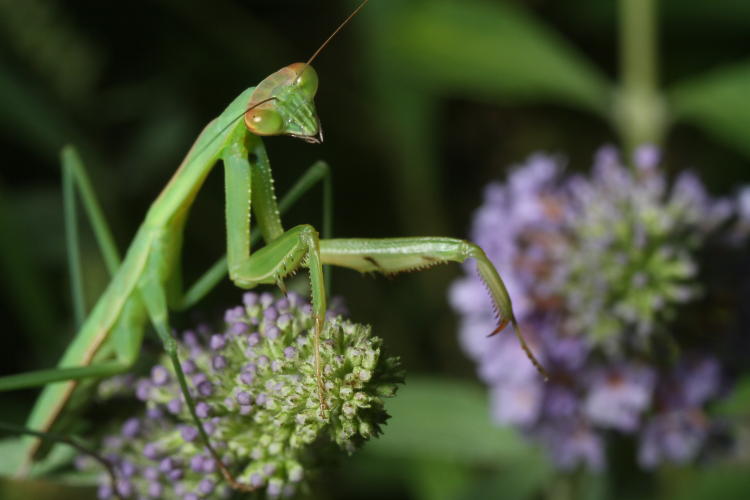
While there don’t seem to be any of the Chinese mantises remaining regularly on the butterfly bushes, they certainly visit often enough, especially the two bushes that sit near the old Japanese maple in the meter – we actually have four Japanese maples now, but three are potted, at least for the time being. The big, original one, that was here when we moved here, has tons of hiding places and is always a favorite of the mantids, though the butterfly bushes attract more prey, so the mantids visit a lot.
And as I said, the rain has been scarce recently, with some overwhelming heat during the day (like low thirties, and that means celsius,) so not only do we spend a lot of time bringing all of the plants water, I go around fairly often with a misting bottle, dousing the prime hiding places. The mantids appreciate this, and will usually scamper excitedly (or so it appears) to the upper leaves to collect as much water as possible, slurping it off of their forelimbs and eyes before it has a chance to evaporate.

Never let it be said that I don’t take care of my photo subjects…
I will close with a couple of frames (well, one) of the largest mantis in the meter, measuring roughly 50mm in length now – about two-thirds adult size, and five times as long as when it was hatched. It gave me a suspicious look from the top of the Japanese maple, but I didn’t have the misting bottle handy. This is the full frame.

Some idea of the thickness of the foliage can be garnered from this image. Below, however, is the same frame, cropped tighter and magnified more to show the detail captured – I always love it when I get the focus this tight, even though I have plenty of examples like this. Mantids, at least, can hold still for a photo.
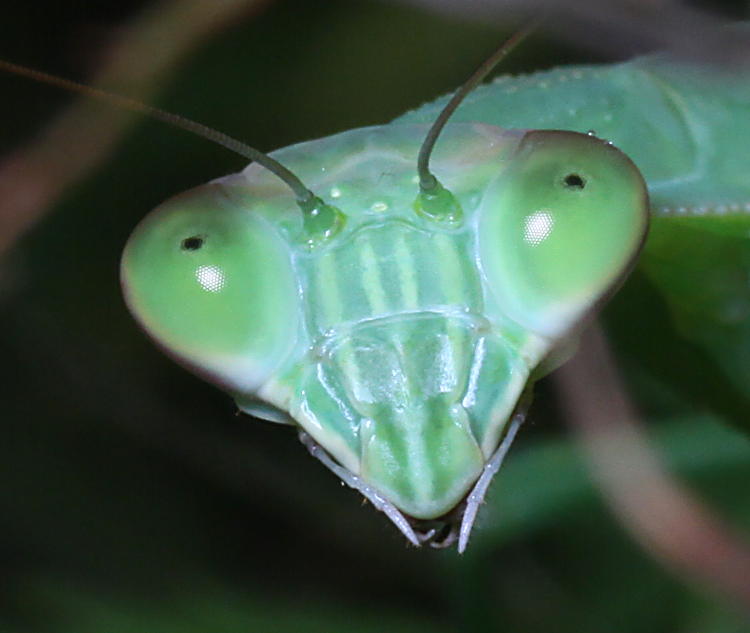
And yes, I wasn’t lying about not having the misting bottle, so those little dewdrops atop one eye were collected from the leaves themselves as the mantis crawled among them. But the false pupils certainly have a bizarre look, don’t they? That’s partially because they’re a little out of focus here – the false pupil is an optical effect within the eye, not atop it.
Coming up: more birds. Still cleaning out the blog folder of the recent stuff.



















































